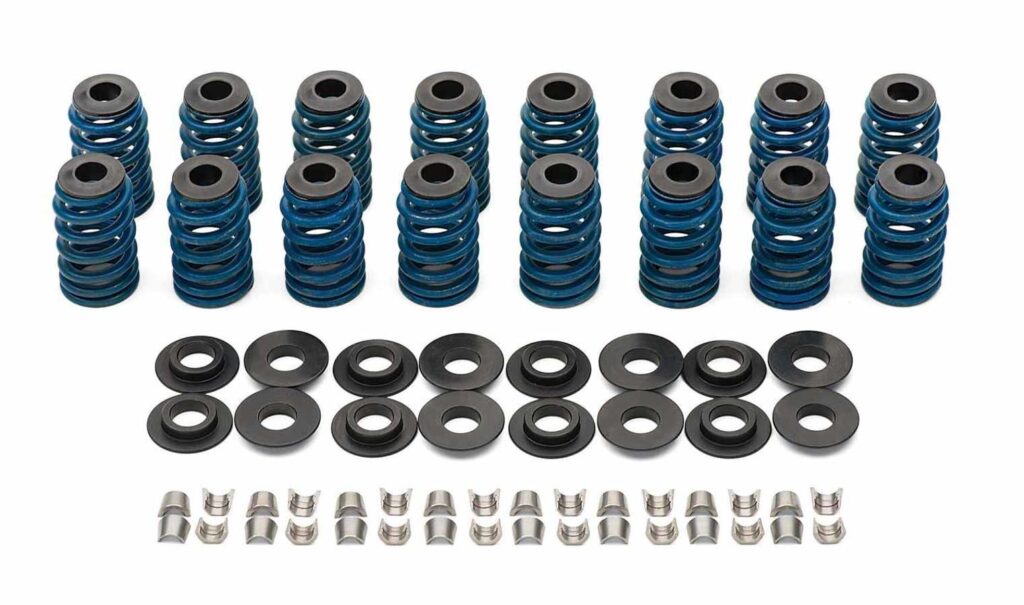Innovation is key when pursuing increased engine efficiency and added horsepower. Leading engine builders, racers, and performance enthusiasts have learned that keeping an open mind to new products or ideas and incorporating them into their program will prevent them from being literally stuck in time. New innovations are constantly happening in different industries, such as military aircraft, and some can lead to significant improvements in automotive performance technology, as well. Look no further than beehive valve springs for an example.
Nitrous oxide systems, for example, were used as performance boosters in military aircraft during World War II, long before their use in automobiles. Lightweight batteries, widely used today in modern race and performance cars, were originally developed for use in military aircraft as well. Beehive valve springs, with their growing use and popularity in the racing and performance industry, were first used in aircraft as well.
While beehive valve springs have seen use in aircraft applications going back to the early 1900’s, it wasn’t until their introduction during the late 1990’s as standard equipment in GM LS, Ford Modular, and Dodge Gen III Hemi V8 engines that many performance enthusiasts began to take notice. According to Jason Youds of PAC Racing Springs, NASCAR teams were among the first to embrace this venerable spring technology, utilizing beehive springs on restrictor plate engines.
Beehive springs continue to gain popularity in both the circle track and drag racing markets, particularly in classes that have strict rules regarding valve spring sizing or that disallow lightweight but costly titanium valve train components. As a result of their increasing popularity, aftermarket suppliers such as PAC and Comp Cams are offering beehive springs for a wide variety of applications, including early model engines that were originally equipped with conventional valve springs.
While traditional valve springs have a constant diameter, a beehive spring tapers in toward the top, making it resemble a real beehive, hence the name. Beehive springs are formed from ovate (oval) wire rather than traditional round wire. The conical shape and ovate wire yield a lighter spring that is proven to equalize stress distribution, provide a more desirable, progressive spring rate, and ultimately, improve engine performance. A beehive spring can also allow more lift without increasing spring height. Most importantly, the ovate wire resists harmonics, a characteristic that leads to harmful valve float, according to Youds.
The development of beehive valve springs has been expedited through the use of the Spintron, a device that uses cameras, sensors, and lasers to study what happens inside an engine. Valve train experts study this data and use it to either improve an existing product or create a new one.

The beehive valve spring has a smaller diameter top, which allows use of a smaller, specially designed retainer for further weight reduction. These lightweight retainers weigh roughly 50% less than a titanium retainer for a conventional valve spring. Engine builders know that reducing valve train weight, specifically on the valve side of the rocker arm, multiplies the lobe acceleration rate by the rocker ratio and results in increased RPM potential without loss of valve control. This is the reasoning behind the fact that titanium valve spring retainers, valve locks, and valves have become standard equipment on many high-end racing engines. Titanium valve train components have their place in motorsports, but are typically out of the sportsman racer’s or street enthusiast’s budget. While a full complement of titanium valve train components can easily run into thousands of dollars, a set of beehive springs and lightweight steel retainers can be purchased for around $200.00.
Although beehive springs have proven very reliable, they are not for everyone. They are generally not designed for use with any high-performance camshaft that requires over 200 lbs. of valve spring seat pressure, or has greater than 0.650″ valve lift. Detractors point out that in the rare occurrence that a spring breaks, no safety margin exists due to the single spring design, and the engine is exposed to catastrophic valve-to-piston contact, which could be prevented with the use of a conventional double or triple spring. It is for this reason that Youds recommends that in the event that beehive springs are used in a racing application and they experience any significant spring pressure loss due to fatigue, that they should be replaced immediately.
While beehive valve springs are certainly not a new concept, their increasing popularity in racing and performance engines ensures that we will continue to see further innovation and improvement.